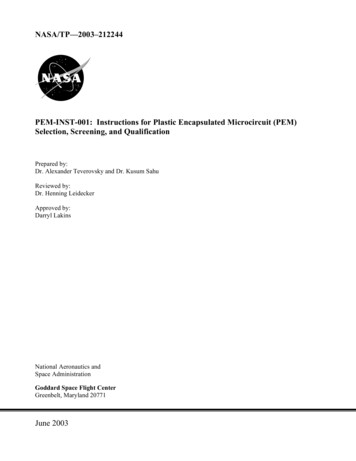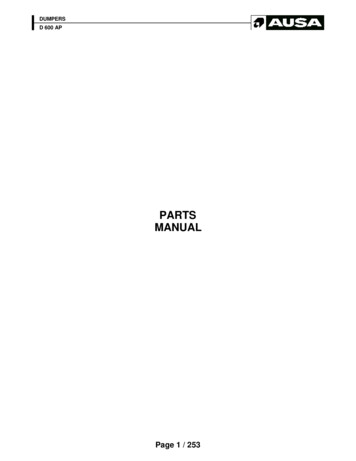
Transcription
NASA/TP—2003–212244PEM-INST-001: Instructions for Plastic Encapsulated Microcircuit (PEM)Selection, Screening, and QualificationPrepared by:Dr. Alexander Teverovsky and Dr. Kusum SahuReviewed by:Dr. Henning LeideckerApproved by:Darryl LakinsNational Aeronautics andSpace AdministrationGoddard Space Flight CenterGreenbelt, Maryland 20771June 2003
The NASA STI Program Office in ProfileSince its founding, NASA has been dedicated to theadvancement of aeronautics and space science. TheNASA Scientific and Technical Information (STI)Program Office plays a key part in helping NASAmaintain this important role.The NASA STI Program Office is operated byLangley Research Center, the lead center forNASA’s scientific and technical information. TheNASA STI Program Office provides access to theNASA STI Database, the largest collection ofaeronautical and space science STI in the world.The Program Office is also NASA’s institutionalmechanism for disseminating the results of itsresearch and development activities. These resultsare published by NASA in the NASA STI ReportSeries, which includes the following report types: CONFERENCE PUBLICATION. Collectedpapers from scientific and technical conferences,symposia, seminars, or other meetings sponsoredor cosponsored by NASA. SPECIAL PUBLICATION. Scientific, technical,or historical information from NASA programs,projects, and mission, often concerned withsubjects having substantial public interest. TECHNICAL TRANSLATION. Englishlanguage translations of foreign scientific andtechnical material pertinent to NASA’s mission.Specialized services that complement the STIProgram Office’s diverse offerings include creatingcustom thesauri, building customized databases,organizing and publishing research results . evenproviding videos. TECHNICAL PUBLICATION. Reports ofcompleted research or a major significant phaseof research that present the results of NASAprograms and include extensive data ortheoretical analysis. Includes compilations ofsignificant scientific and technical data andinformation deemed to be of continuing referencevalue. NASA’s counterpart of peer-reviewedformal professional papers but has less stringentlimitations on manuscript length and extent ofgraphic presentations. Access the NASA STI Program Home Page athttp://www.sti.nasa.gov/STI-homepage.html TECHNICAL MEMORANDUM. Scientific andtechnical findings that are preliminary or ofspecialized interest, e.g., quick release reports,working papers, and bibliographies that containminimal annotation. Does not contain extensiveanalysis. Telephone the NASA Access Help Desk at(301) 621-0390 CONTRACTOR REPORT. Scientific andtechnical findings by NASA-sponsoredcontractors and grantees.For more information about the NASA STI ProgramOffice, see the following: E-mail your question via the Internet tohelp@sti.nasa.gov Fax your question to the NASA Access HelpDesk at (301) 621-0134 Write to:NASA Access Help DeskNASA Center for AeroSpace Information7121 Standard DriveHanover, MD 21076–1320
NASA/TP—2003–212244PEM-INST-001: Instructions for Plastic Encapsulated Microcircuit (PEM)Selection, Screening, and QualificationPrepared by:Dr. Alexander Teverovsky and Dr. Kusum Sahu, Goddard Space Flight Center, Greenbelt, MDReviewed by:Dr. Henning Leidecker, Goddard Space Flight Center, Greenbelt, MDApproved by:Darryl Lakins, Goddard Space Flight Center, Greenbelt, MDNational Aeronautics andSpace AdministrationGoddard Space Flight CenterGreenbelt, Maryland 20771June 2003
PEM-INST-001ContentsPage 1 of 44TABLE OF CONTENTSSECTION1.2.3.4.5.6.7.8.9.10.11.PAGETable of Contents1List of Tables2List of Figures2Preface3NASA/GSFC PEMs Policy4Product Assurance System for PEMs62.1Scope62.2Product Assurance System (Screening,Qualification, and DPA)62.3Additional Evaluations72.4Requirements for PEMs by Project Risk Levels8Requirements for Screening9Requirements for Qualification16Destructive Physical Analysis (DPA)205.1Purposes of DPA for PEMs205.2DPA Test Flow205.3GSFC DPA Procedure225.3.1External Visual Examination225.3.2Radiography225.3.3Acoustic Microscopy (C-SAM)225.3.4Package Level Cross-Sectioning245.3.5Internal Visual Inspection265.3.6Bond Pull Test275.3.7Glassivation Layer Integrity285.3.8Assembly Examination Using Scanning Electron Microscope (SEM) 275.3.9Die Metallization Examination Using SEM28Evaluation Analysis30Derating Requirements31Handling and Storage Requirements32Information From Manufacturers33Appendix A: Basis for GSFC Policy on the Use of PEMs35Appendix B: Product Assurance Methodology43
PEM-INST-001ContentsPage 2 of 44LIST OF TABLESTABLEPAGETable 1GSFC PEM Requirements8Table 2GSFC Screening Requirements for PEMS10Table 2ABurn-in and Electrical Measurement Requirements for PEMs13Table 3GSFC Qualification Requirements for PEMS18Table 4Derating Requirements for PEMs31Table 5Manufacturer Information33LIST OF FIGURESFIGUREFigure 1PAGEProduct Assurance System for PEMs and Its RelationshipWith Reliability During the Part Lifespan7Figure 2A Typical Test Flow for Screening of PEMs9Figure 3A Typical Qualification Test Flow for PEMs17Figure 4A Typical DPA Test Flow for PEMs21Figure 5PEM Evaluation Process42Figure 6GSFC Product Assurance System for PEMs44
PEM-INST-001PrefacePage 3 of 44PREFACEPotential users of plastic encapsulated microcircuits (PEMs) need to be reminded that unlike the militarysystem of producing robust high-reliability microcircuits that are designed to perform acceptably in avariety of harsh environments, PEMs are primarily designed for use in benign environments whereequipment is easily accessed for repair or replacement. The methods of analysis applied to militaryproducts to demonstrate high reliability cannot always be applied to PEMs. This makes it difficult forusers to characterize PEMs for two reasons:1.Due to the major differences in design and construction, the standard test practices used to ensurethat military devices are robust and have high reliability often cannot be applied to PEMs that havea smaller operating temperature range and are typically more frail and susceptible to moistureabsorption. In contrast, high-reliability military microcircuits usually utilize large, robust, hightemperature packages that are hermetically sealed.2.Unlike the military high-reliability system, users of PEMs have little visibility into commercialmanufacturers’ proprietary design, materials, die traceability, and production processes andprocedures. There is no central authority that monitors PEM commercial product for quality, andthere are no controls in place that can be imposed across all commercial manufacturers to provideconfidence to high-reliability users that a common acceptable level of quality exists for all PEMsmanufacturers. Consequently, there is no guaranteed control over the type of reliability that is builtinto commercial product, and there is no guarantee that different lots from the same manufacturerare equally acceptable. And regarding application, there is no guarantee that commercial productsintended for use in benign environments will provide acceptable performance and reliability inharsh space environments.The qualification and screening processes contained in this document are intended to detectpoor-quality lots and screen out early random failures from use in space flight hardware.However, since it cannot be guaranteed that quality was designed and built into PEMs thatare appropriate for space applications, users cannot screen in quality that may not exist. Itmust be understood that due to the variety of materials, processes, and technologies used to designand produce PEMs, this test process may not accelerate and detect all failure mechanisms. Whilethe tests herein will increase user confidence that PEMs with otherwise unknown reliability can beused in space environments, such testing may not guarantee the same level of reliability offeredby military microcircuits. PEMs should only be used where due to performance needs thereare no alternatives in the military high-reliability market, and projects are willing to accepthigher risk.
PEM-INST-001Section 1. NASA GSFC PEMs PolicyPage 4 of 441. NASA/GSFC PEMS POLICYThe use of plastic encapsulated microcircuits (PEMs) is permitted on NASA Goddard Space Flight Center(GSFC) space flight applications, provided each use is thoroughly evaluated for thermal, mechanical, andradiation implications of the specific application and found to meet mission requirements. PEMs shall beselected for their functional advantage and availability, not for cost savings; the steps necessary to ensurereliability usually negate any initial apparent cost advantage. A PEM shall not be substituted for a form,fit, and functional equivalent, high-reliability, hermetic device in space flight applications.Due to the rapid change in wafer-level designs typical of commercial parts and the unknown traceabilitybetween packaging lots and wafer lots, lot-specific testing is required for PEMs, unless specificallyexcepted by the Mission Assurance Requirements (MAR) for the project. Lot-specific qualification,screening, and radiation hardness assurance analysis and/or testing shall be consistent with the requiredreliability level as defined in the MAR.Developers proposing to use PEMs shall address the following items in their Performance AssuranceImplementation Plan: source selection (manufacturers and distributors), storage conditions for all stagesof use, packing, shipping and handling, electrostatic discharge (ESD), screening and qualification testing,derating, radiation hardness assurance, test house selection and control, and data collection and retention.Use of PEMs outside the manufacturer’s rated temperature range requires written approval from GSFC.Specifically, PEMs must be: Stored under temperature-controlled, clean conditions, protected from ESD and humidity.Traceable to the branded manufacturer.Procured from the manufacturer or their approved distributor.Tested to verify compliance with the performance requirements of the application environmentover the intended mission lifetime.Tested using practices and facilities with demonstrated capabilities sufficient to handle and test thetechnologies involved.Testing in accordance with EEE-INST-002 shall be performed as necessary to qualify and screen thedevices, in order to verify compliance with the application requirements and project risk level defined inthe program MAR. Radiation evaluation shall address all threats appropriate for the technology,application, and environment, including Total Ionizing Dose (TID), Single Event Effects (SEE), anddisplacement damage. Existing radiation data can be used only with the review and approval of theproject radiation specialist.PEMs with manufacture dates older than 3 years before the time of installation shall not be used withoutGSFC approval. Derating of PEMs must be addressed with consideration of specific material, deviceconstruction, device characteristics, and application requirements.Use of PEMs with pure tin-plated terminations requires special precautions to preclude failures caused bytin whiskers. GSFC approval of mitigation strategies is required.
PEM-INST-001Section 1. NASA GSFC PEMs PolicyPage 5 of 44Exceptions to testing required by EEE-INST-002 may be permitted by GSFC on a case-by-case basis,where it can be demonstrated that either existing lot-specific test data show acceptable results, or the useof high-risk PEMs represents low risk of functional loss should the part fail. All rationale for suchexceptions shall be documented.NASA will use part performance data collected in accordance with this policy to evaluate the policy’seffectiveness and to develop recommendations for future improvements and streamlining.
PEM-INST-001Section 2. PEMs ProductAssurance SystemPage 6 of 442.0 PRODUCT ASSURANCE SYSTEM FOR PEMS2.1ScopeThis document establishes a system of product assurance for PEMs in order to invoke the GSFC PEMpolicy. It is based partly on existing qualification system for military and aerospace components,experience accumulated by the parts engineering community, and practices or guidelines established byhigh-reliability electronics industry.2.2Product Assurance System (Screening, Qualification, and DPA)Purpose. The purpose of this product assurance system is to mitigate the risk of PEM usage, evaluatelong-term reliability of the parts, and prevent failures. Commercial PEMs are primarily designed forbenign environments and are considered as high-risk parts when used in space applications. For thisreason, no PEMs are considered acceptable in high-reliability applications “as is” withoutadditional testing and analysis to assure adequate reliability and radiation tolerance.Primary Elements of the Product Assurance SystemScreening. The purpose of screening is to detect and remove defective parts and reduce infant mortalityfailures. The screening process proactively evaluates the reliability of the lot.Qualification. The purpose of qualification testing is to ensure that no wear-out mechanisms would causepremature failures during the part storage, ground phase integration period, and spacecraft mission. Thequalification process provides information regarding reliability of the design and the technology.Radiation Hardness. Radiation effects on the parts (Total Ionization Dose [TID] and Single Event Effects[SEE]) must be assessed on a lot-specific basis according to the project requirements.Destructive Physical Analysis (DPA). The purpose of DPA is to determine whether the lot has anydesign, material, workmanship, or process flaws that may not show up during screening and qualificationtests and cause degradation or failures during the hardware integration period and spacecraft missionlifetime. When obvious gross defects are revealed during DPA, it is usually an indication thatmanufacturer’s processes are out of control, and a replacement of the lot might be required. Therefore, itis recommended that DPA should be performed prior to screening and qualification of the lot.Anomalies revealed by DPA raise concerns regarding quality and reliability of the parts. These concernsmay be further addressed by tailoring screening and qualification procedures or by performing additionaldesign evaluation and testing of the parts (refer to Section 6).A relationship between the major elements of the product assurance system (screening, qualification, andDPA) and reliability of the parts can be illustrated using a classic bathtub-shaped curve of the lifespanfailure rate shown in Figure 1. The three elements of the system discussed have been widely used forhigh-reliability parts and remain the major means to provide high-quality PEMs for space projects.
PEM-INST-001Section 2. PEMs ProductAssurance SystemPage 7 of 44Figure 1. Product Assurance System for PEMs and Its RelationshipWith Reliability During the Part Lifespan2.3Additional EvaluationsAdditional evaluations might be necessary to further mitigate risks associated with the use of PEMs.These assessments shall include:Design Evaluation. Additional part- and application-specific evaluations performed beyond standardscreening, qualification, or DPA may be necessary. Refer to Section 6, which describes capabilities ofthis element of the product assurance system.Manufacturer History. The manufacturer’s history of ability to produce consistent reliability and qualityshould be reviewed (refer to Section 9).Distributor. Use of reputable distributors is essential to avoid procurement of counterfeit parts. Use ofbrokers is not recommended. Distributor compliance to PEMs handling and storage requirements shouldbe assessed.Qualification by Flight History. For all PEMs, qualification by flight history or similarity is notacceptable. Commercial PEM manufacturers are known to produce the same part number with diesourced from different wafer lots having different die revisions. The same part number may also be madeby multiple production plants, processed according to requirements that vary between wafer and assembly
PEM-INST-001Section 2. PEMs ProductAssurance SystemPage 8 of 44plants. However, the history of parts’ application is important and allows addressing specific problems ofdesign and technology of the parts revealed previously.2.4Requirements for PEMs by Project Risk LevelsRequirements for use of PEMs in GSFC projects are shown in Table 1 for different project risk levelsdefined in EEE-INST-001.Table 1. GSFC PEM Requirements 1/Selection PriorityLevel 1Screening(See Section 3)XQualification(See Section 4)XDPA(See Section 5)XLevel 2XXXLevel 3XXXNotes:1/PEMs qualified according to this document are intended for operation within the manufacturer’s data sheetlimits. Any uprating and use of PEMs outside the manufacturer’s specified range, particularly thetemperature limits, is not acceptable.
PEM-INST-001Section 3. PEMs ScreeningPage 9 of 443.0 REQUIREMENTS FOR SCREENINGGeneral. Screening is the only element of the product assurance system, which is applied to all flightparts by testing and inspecting every sample, and proactively affects reliability of the lot. Refer to Tables2 and 2a for screening requirements of PEMs for projects of different risk levels.Handling. There are numerous data indicating that improper handling and testing of the parts canintroduce more defects than are screened out. Therefore, extreme caution should be taken duringhandling, storage, and testing to reduce the possibility of electrostatic discharge (ESD), electricaloverstress (EOS), contamination, and mechanical damage to the parts. This demands scrupulous attentionto the practice and requirements of handling and storage of the flight parts. Guidelines and requirementsfor handling and storage of PEMs are described in Section 8 of this document. A typical test flow forscreening of PEMs is shown in Figure 3.Figure 2. A Typical Test Flow for Screening of PEMs(See Table 2 for details of GSFC screening requirements for PEMs.)
PEM-INST-001Section 3. PEMs ScreeningPage 10 of 44Table 2. Screening Requirements for PEMs 1/ScreenLevel 1Level 2Level 3XXXTemperature cycles, minimum.2020203. Radiography 3/Per paragraph 5.3.2.XXX4. C-SAM inspection 4/Per paragraph 5.3.3.XXX5. Initial (pre-burn-in)electrical measurements(EM) 5/Per device specification, at 25 CXXXXX-240 hrs. at125 C445 hrs. at105 C885 hrs. at 85 C1,560 hrs. at70 C160 hrs. at125 C300 hrs. at105 C590 hrs. at 85 C1,040 hrs. at70 C160 hrs. at125 C300 hrs. at105 C590 hrs. at 85 C1,040 hrs. at70 CXXXSame astest step 7.Same astest step 7.Same astest step 7.1. External visual, andserialization 2/2. Temperature cyclingTest Method and ConditionsPer paragraph 5.3.1.MIL-STD-883, Method 1010,Condition B (or to themanufacturer’s storage temperaturerange, whichever is less).At min. and max. rated operationaltemperatures.6. Engineering review (steps1 to 5) 6/7. Static (steady-state)burn-in (BI) test at 125 Cor at max. operatingtemperature 7/MIL-STD-883, Method 1015,condition A or B.7a. Post static BI electricalmeasurements at 25 CPer device specification. CalculateDelta when applicable.9. Dynamic burn-in test at125 C or at max.operating temperature 7/MIL-STD-883, Method 1015, Cond.D.Hours, minimum.10. Final parametric andfunctional testsPer device specification (at 25 C,maximum, and minimum ratedoperating temperatures).XXXMaximum acceptable PDA.5%10%10%XXX11.Calculate percentdefective (steps 7 to 10)6/12. External visual/packing2/Notes on next page.Hours, minimum depending on theBI temperature.Per paragraph 5.3.1 and Section 8.
PEM-INST-001Section 3. PEMs ScreeningPage 11 of 44Notes to Table 2. Screening Requirements for PEMs1/General1.1/ Screening is performed on 100% of flight parts.1.2/ Historically, only parts with tight lot-specific controls imposed during manufacturing had been allowedfor applications in level 1 projects. Such a control is impossible for PEMs, and the suggested screeningprocedures are not considered as a substitute for manufacturing control, but rather as risk mitigationmeasures.1.3/ It is the responsibility of the project parts engineer to submit screening test results to Code 562 forlogging into the Code 562 PEM database.2/3/It is recommended to combine the incoming/outgoing visual inspections with the serialization andpackaging to reduce handling and possible damage to the parts. Serialization should be performed in sucha way to allow a top side C-SAM inspection. Flight parts should be handled and stored in a manner toprevent mechanical and ESD damage, contamination, and moisture absorption (see Section 8).To minimize handling, only a top view X-ray inspection is required. Focus to inspect for wire sweepingand obvious defects in the part. Depending on the results of the top view X-ray and/or part construction, aside view may be required.4/Acoustic Microscopy (C-SAM)4.1/General. Acoustic microscopy is performed to screen out defects at critical die surface and lead tipwire-bond areas of the parts and screening, except for power devices, is performed only at the topside.4.2/Coated Die. Top side of the internal portion of the leads is inspected in PEMs with polymer diecoating. Inspection of the die area is not required, as the die coating has a low acoustic impedancethat appears as a false delamination.4.3/Power Devices. For power parts, the bottom side inspection of die attachment might be replaced withthe thermal impedance measurements.4.4/Rejection Criteria. Any measurable amount of delamination between molding compound and the die surface. Any delaminations on the leads at wire bond areas. Delaminations extending more than 2/3 the length of internal part of the leads.5/Electrical Measurements5.1/Special Testing. In addition to parametric and functional measurements per data sheets, supplement and/orinnovative testing techniques (e.g. IDDQ leakage currents, thermal impedance, output noise, etc.) can be used toselect better quality parts from the lot (cherry pick) as flight candidates. These techniques should be certifiedand approved by Code 562.5.2/Failure modes (parametric or catastrophic) should be recorded for each failed part.6/Engineering Review6.1/ More than 10% C-SAM rejects might require additional evaluation of thermo-mechanical integrity of the lot or itsreplacement.6.2/ Most established PEMs manufacturers guarantees 3-sigma level process minimum, which means that less than0.27% of the parts can be out of specification. Excessive fallouts during initial electrical measurements at roomtemperature might be due to a poor quality of the lot or effect of temperature cycling performed before electricalmeasurements, or it might be an indication of problems with the testing lab. When excessive rejects areexperienced, the project PE decides whether a lot replacement or additional evaluation is needed based on observedfailure modes and results of failure analysis. Excessive rejects during initial electrical measurements might be alegitimate cause for lot replacement.
PEM-INST-001Section 3. PEMs ScreeningPage 12 of 44Notes to Table 2 (Continued). Screening Requirements for PEMs7/Burn-in (BI)7.1/General. Burn-in is a complex, product-specific test and if possible should be conducted by themanufacturer of the part. If a user performs this test, special care should be taken not to exceedmaximum current, voltage, and die temperature limits.7.2/Burn-in Temperature. The BI temperature is a “stress” temperature used to precipitate failure ofdefective parts and is typically much higher than the operational temperature of the part, where thecharacteristics are guaranteed to remain within the data sheet limits. Most PEM manufacturers usetemperatures in the range from 125 C to 150 C to periodically perform BI to monitor quality oftheir product. However, if the parts engineer is unable to justify the suitability of burn-in at 125 C,the burn-in ambient temperature shall be limited to the maximum operating temperature per thedevice specifications provided by the manufacturer.7.3/Junction Temperature. The junction temperature during BI testing should not exceed the absolutemaximum rated junction temperature for the part.7.4/Molding Material Glass Transition Temperature. When the die temperature is close to or exceedsthe glass transition temperature (Tg) of the molding compound (MC), electrical and mechanicalproperties of MC may change significantly and new degradation mechanisms may cause failures ofthe part. For most molding compounds, Tg values exceed 140 to 150 C, which gives a necessarytemperature margin for 125 C BI. Reliability of the PEMs, which are manufactured with low-Tgmolding compounds (Tg 120 C), is difficult to assess, and such parts are not recommended forspace projects without additional extensive analysis and testing. Glass transition temperaturemeasurements are recommended prior to BI if usage of low-Tg molding compound for the lot issuspected.7.5/Protection. In some parts the sensitivity of the input/output ESD protection circuits increases withtemperature and these circuits can be turned on easily, at lower and/or shorter voltage spikes, than atroom temperature. For this reason, special care should be taken to prevent possible power linetransients during burn-in testing.7.6/Excessive proportion of functional BI failures, even when the total number of failures is within thePDA limits, might be an indication of serious lot reliability problems. In these cases additionaltesting and analysis of the parts might be required.7.7/Steady-state burn-in is performed on all linear and mixed-signal devices (see Table 2A for details onburn-in conditions). The duration of steady-state burn-in can be reduced 50% if the parts are to besubjected to dynamic burn-in testing.7.8/Dynamic burn-in is not required for parts operating under steady-state conditions, e.g. voltagereferences, temperature sensors, etc.7.9/Only one type of BI test, either static or dynamic, is required for level 2 and 3 parts.7.10/Under special circumstances, when it is technically and economically viable, and for components,which are difficult to assess at the piece part level, alternative testing in lieu of static and/or dynamicBI testing (for example, board-level burn-in) may be permitted. It is the responsibility of the projectPE to document and submit a rationale for the technical feasibility and equivalency of the alternativetesting to the project and GSFC Code 562 for approval. Board-level burn-in shall not be routinelysubstituted for piece part burn-in as a convenience.
PEM-INST-001Section 3. PEMs ScreeningPage 13 of 44Table 2A. Burn-in and Electrical Measurement Requirements for PEMsIC TypeDigital Bipolar &Digital MOS/BiCMOS:LOGIC (Gates, Buffers,Flip-Flops,Multiplexers, Registers,and Counters)RAMsFIFOsMicroprocessorsInterface PeripheralsASICsFPGA, PROM, PALLinear MOS, Bipolar,and Bi-FET: 5/Op-Amp, InstrumentAmplifiers, S/H, andComparatorNotes at end of Table 2A.Required Burn-In 1/StaticDynamic(Condition C) 2/(Condition D) 2/Required for both technologies.Not required for Digital BipolarTechnology.Vin Square wave, 50% duty cycle toinput pins and control pins.Required for Digital MOSTechnology.Frequency 100 Hz to 1 Mhz.VIN VDD across one-half input pinsand VSS across the remainingVOUT VCC /2 or VDD/2 through RL.inputs.Delta ICCor IDDDC: VIC, VOH, VOL, ICC(IEE), IIL,IIH, IDD, IOZL, IOZH, IOSAC: TPLH, TPHL, TTLH, TTHL, TPZH,TPHZ, TPLZ, TPZL, TA, TS, THFunctional Tests:a) For simple logic devices, verifytruth table.VOUT 0.5 VDD through RLVout Terminated to ground throughRLElectricalMeasurements 3/, 4/b) For complex logic devices suchas ASIC, FPGA, andmicroprocessors, functionaltesting should include faultcoverage calculations.Vin Square wave or sinewaveF 10Hz to 100 KHz, 50% duty cycleVout Terminated to ground through RL IIB IIO VIOc) For PROMs, check fuse map;for RAMs, perform patternsensitive tests such as March,Galpat, etc.DC: ICC, IEE, IIO, VIO, VOPP, AV,CMRR, PSRRAC: Slew rate
PEM-INST-001Section 3. PEMs ScreeningPage 14 of 44Table 2A (Continued). Burn-in and Electrical Measurement Requirements for PEMsRequired Burn-In 1/IC TypeLinear MOS, Bipolarand JFET: 5/Line Drivers andReceiversStatic(Condition C) 2/Vin VDD max across one-half inputpins and VSS across theremaining inputs.Dynamic(Condition D) 2/Vin Square wave at a specifiedfrequency and duty cycleDelta ICC IIHVout VCC through RLVin VDD max across one-half ofinputs and VSS across theother remaining inputs.Vout VCC through RLVin Square waveF 100 Khz and 50% duty cycleVout VCC through RL ICC ID(OFF) IS(OFF) R(ON)Linear Bipolar:Voltage RegulatorsLinear Bipolar:Pulse-width-modulatorVout Terminated to ground throughRLNot requiredNot required ISCD VOUT IIO VREFLinear CMOSTimersTA 125 CNot requiredVout VCC through RLDC: VOH, VOL, ICC, IIL, IIH,IOSAC: TPLH, TPHL, TTLH, TTHLLinear MOS, Bi-FET,and Bipolar: 5/Analog Switches andMultiplexersVout Terminated to ground through RLRext, Cext connected if applicable.ElectricalMeasurement 3/, 4/ ICEX VOH VOLFunctional Test: Verifytruth tableDC: ICC, ID(ON), R(ON),ID(OFF), IS(ON), IS(OFF)AC: T(ON) , T(OFF)break- before- make- timeDC: ICC, VOUT, IOS,line/load regulationDC: VREF, IIB, IIO, IOS, VIO,VOL, VOH, AV, CMRR,PSRRAC: TR , TF, fOSCDC: VTRIG, VTH, VR, VOL,VOH, VSAT, ICC, ITRIG, ITH, IR,ICEXAC: TTLH, TTHLNotes at end of Table 2A.
PEM-INST-001Section 3. PEMs ScreeningPage 15 of 44Table 2A (Continued). Burn-in and Electrical Measurement Requirements for PEMsRequired Burn-In 1/IC TypeMixed Signal MOS,Bi-CMOS andBipolar: 5/Analog to Digital(A/D) Converters.Mixed Signal MOS,Bi-CMOS and Bipolar5/Digital to Analog(D/A) Converters.Static(Condition C) 2/Vin Max analog DC inputVout VCC/2 through RLDynamic(Condition D) 2/Vin Analog input to generate maximumdigital codes.Vout VCC/2 through RLDeltaVin VDD on one-half data inputsand VSS on remaining input
GSFC approval. Derating of PEMs must be addressed with consideration of specific material, device construction, device characteristics, and application requirements. Use of PEMs with pure tin-plated terminations requires special precautions to preclude failures caused by tin whiskers. GSFC approval of mitigation strategies is required.










